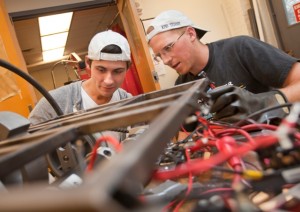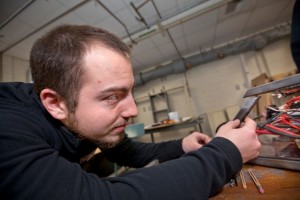
Nathan Terwilliger '11 and Alex Mednick '11 work on the battle bot.
A team of 12 senior mechanical engineering majors is designing and building a tactical combat robot (TCR) as a senior capstone project. The team will attempt to use its battle bot to disarm and disable other TCRs at the eighth annual RoboGames in San Mateo, Calif., April 15-17.
Working on a real-world project with team dynamics and constraints on time and resources is the type of experience the future engineers will find in a professional setting.
“This experience working hands-on in a group on a manufacturing project will impress any employer,” says Nathan Terwilliger (Honesdale, Pa.).

Tom Kondash '11
Each TCR in the competition will be remotely operated by the team members. It will battle against other 120-lb TCRs, armed with vertical or horizontal spinning weapons such as hammers, hatchets, clamps, and saws. The bots face off in a 25-by-25-foot steel-floored arena surrounded by spikes. Although the goal is to destroy the opposing team’s TCR, points are also awarded for inflicting damage. Following each round, the winning team has a limited amount of time to make repairs to its bot.
Each team member is responsible for a different aspect of designing and building the bot. Some work on the frame, while others focus on the drive system, primary weapon, or recovery system.
“There is a large team effort required to make sure it is one working robot as opposed to a bunch of separate subsystems,” says Scott Blond (Syosset, N.Y.).
Although none of the team members has experience specifically in robotics, their sophomore course in manufacturing and design laid the framework needed to participate in Robogames.
“That course really prepares you for the mindset you need to go into any engineering and design project,” says Terwilliger. The students also have the guidance of adviser Steven Nesbit, professor of mechanical engineering, who mentored last year’s team as well.
At this point, the team has completed its design work and spending a lot of time in the shop welding, machining, and troubleshooting. The students hope to have the frame and drive system ready soon so that they have plenty of time to practice maneuvering the TCR before the competition.
The Robogames guidelines specify that the battle bots cannot have weapons that launch projectiles, but otherwise, teams have a lot of leeway in design.
“Anything that stays on your bot is fair game,” says team leader Alexander Mednick (Nelson, N.H.).
The bot will feature a spinning steel disk armed with a tooth to inflict damage on other bots. “It gets going at an ungodly speed,” Mednick says.
It will also include a flipper arm recovery system, which should upright the bot if it gets flipped over in combat.
Mednick says he likes their bot’s chances at the competition. “As long as our frame holds together, and it should, if all else fails, we can just run into them really hard,” he says.
The team also includes Stephanie Bereday (Irvington, N.Y.), Andy Casey (Malvern, Pa.), William Collins (Seven Valleys, Pa.), James Hilbert (Whippany, N.J.), Tommy Kondash (State College, Pa.), Conor O’Neill (Plymouth Meeting, Pa.), Greg Quartier (Huntington, N.Y.), and Matt Russell (Landing, N.J.).


1 Comment
Comments are closed.